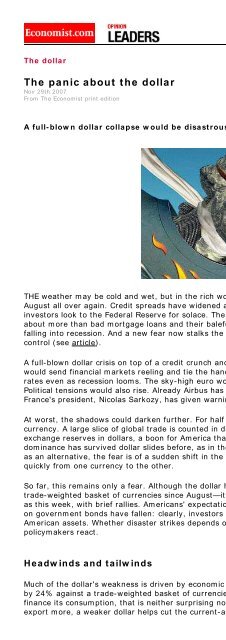The Economist December 1st 2007 - Online Public Access Catalog
The Economist December 1st 2007 - Online Public Access Catalog
The Economist December 1st 2007 - Online Public Access Catalog
- No tags were found...
You also want an ePaper? Increase the reach of your titles
YUMPU automatically turns print PDFs into web optimized ePapers that Google loves.
<strong>The</strong> dollar<strong>The</strong> panic about the dollarNov 29th <strong>2007</strong>From <strong>The</strong> <strong>Economist</strong> print editionA full-blown dollar collapse would be disastrous. Thankfully, it need not happenTHE weather may be cold and wet, but in the rich world's financial markets it is beginning to feel likeAugust all over again. Credit spreads have widened and shares are pitching from gloom to elation asinvestors look to the Federal Reserve for solace. <strong>The</strong> anxiety is unmistakable. But this time the scare isabout more than bad mortgage loans and their baleful effect on the credit markets. America may befalling into recession. And a new fear now stalks the markets: that the dollar's slide could spin out ofcontrol (see article).A full-blown dollar crisis on top of a credit crunch and a weakening economy would be frightening. Itwould send financial markets reeling and tie the hands of the Fed, perhaps forcing it to raise interestrates even as recession looms. <strong>The</strong> sky-high euro would soar further, choking off Europe's growth.Political tensions would also rise. Already Airbus has called the dollar's decline “life-threatening” andFrance's president, Nicolas Sarkozy, has given warning of “economic war”.At worst, the shadows could darken further. For half a century the dollar has been the hegemoniccurrency. A large slice of global trade is counted in dollars. Central banks hold most of their foreignexchangereserves in dollars, a boon for America that has allowed it to issue debt more cheaply. Thatdominance has survived dollar slides before, as in the late 1970s and mid-1980s. But now, with the euroas an alternative, the fear is of a sudden shift in the global monetary system, with investors switchingquickly from one currency to the other.So far, this remains only a fear. Although the dollar has been falling at quite a lick—down 6% against atrade-weighted basket of currencies since August—it has seen no chaotic slump, but a slide interspersed,as this week, with brief rallies. Americans' expectations of future inflation have not yet risen much. Yieldson government bonds have fallen: clearly, investors do not yet expect higher premiums for safeAmerican assets. Whether disaster strikes depends on what exactly is driving the dollar down and on howpolicymakers react.Headwinds and tailwindsMuch of the dollar's weakness is driven by economic fundamentals. Since peaking in 2002, it has fallenby 24% against a trade-weighted basket of currencies. Given America's need to borrow from abroad tofinance its consumption, that is neither surprising nor sinister. By inducing Americans to import less andexport more, a weaker dollar helps cut the current-account deficit. For America, the medicine has been
















